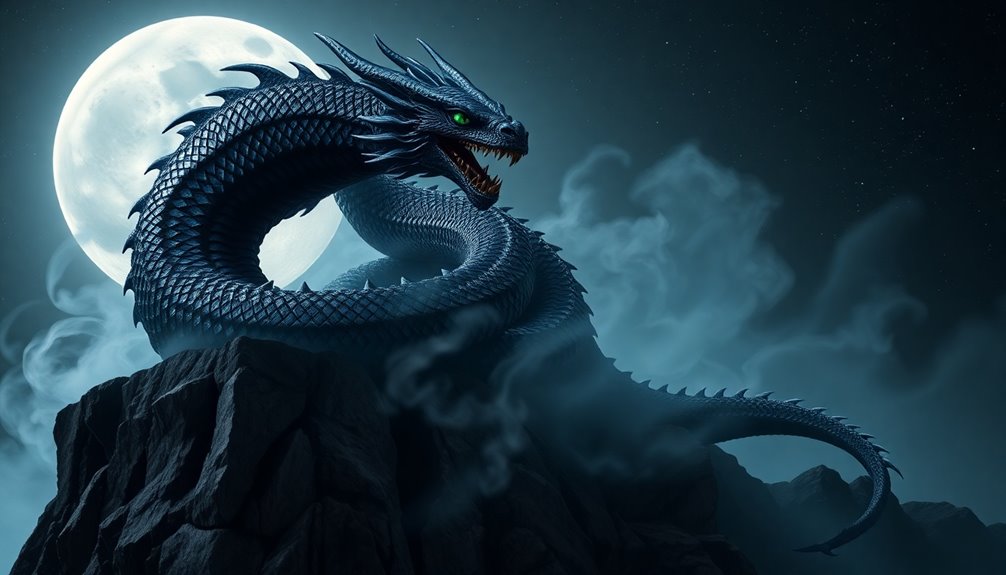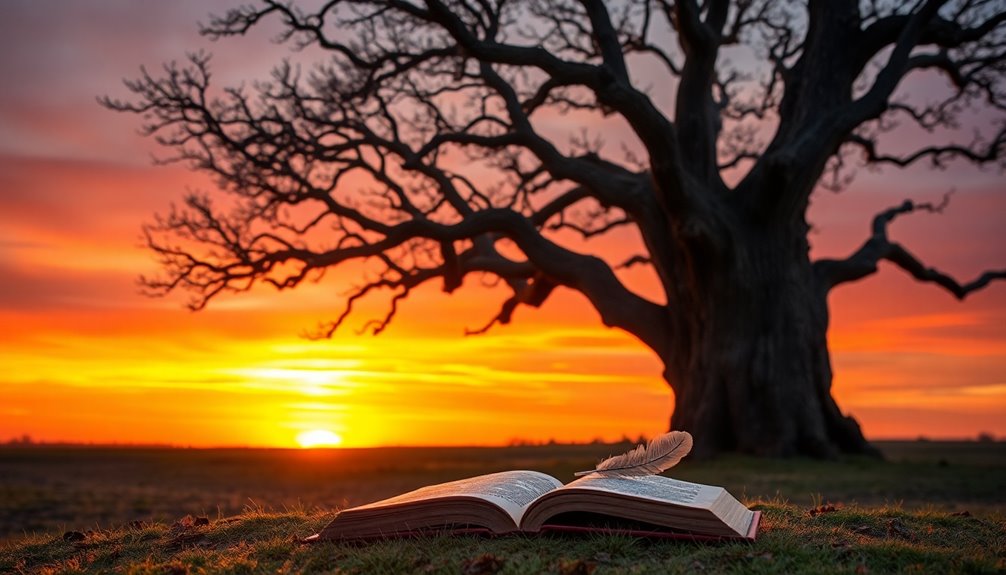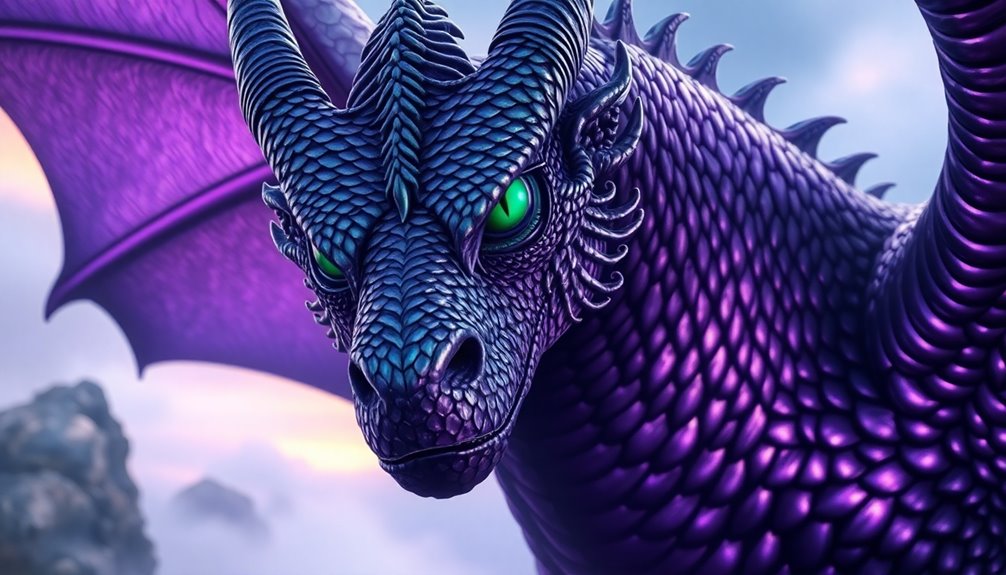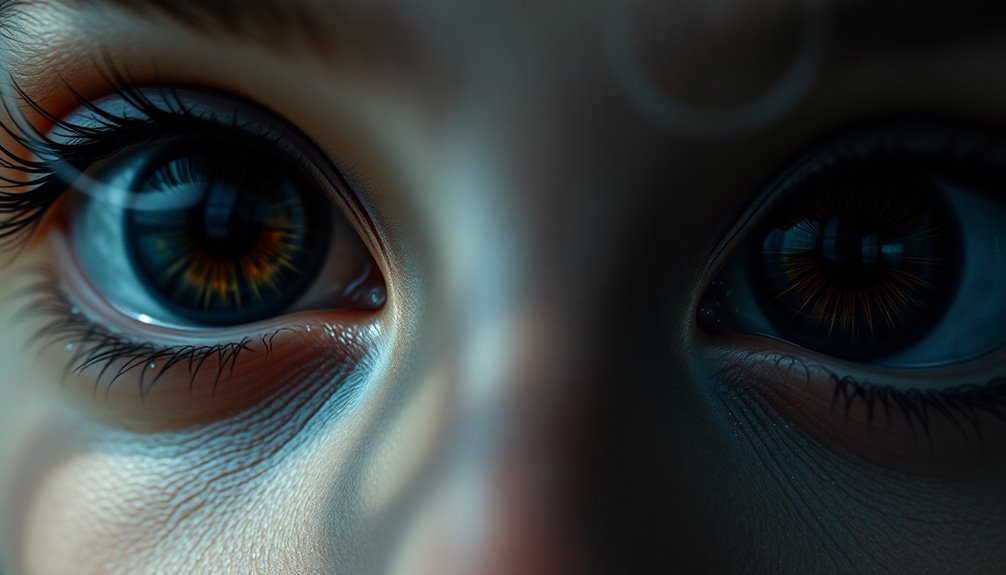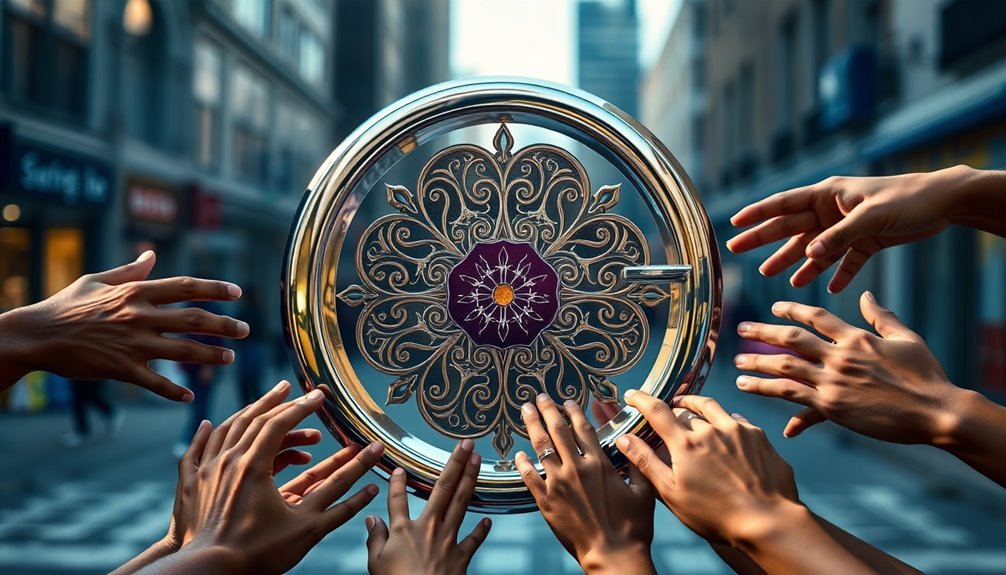Black dragons symbolize the guardianship of secrets and power, representing both destruction and protection. In various cultures, they embody wisdom and authority, often linked with water's life-giving properties. This dual nature means they challenge you to confront your fears while guiding you toward personal transformation. As protectors, black dragons invite introspection and self-discovery, facilitating spiritual growth. Their presence in martial arts and art reflects their strength and dominance, demonstrating resilience and perseverance. If you explore further, you'll uncover the rich tapestry of meanings behind these fascinating creatures and their impact on culture and personal journeys.
Key Takeaways
- Black dragons symbolize wisdom and power, serving as guardians of secrets and the mystical realms of existence.
- They embody internal conflicts, encouraging personal transformation through the exploration of fears and hidden truths.
- In Chinese mythology, black dragons are associated with authority and agricultural abundance, highlighting their protective nature.
- As symbols of strength and dominance, black dragons represent the balance between chaos and order in life.
- Their presence in art and modern media portrays them as enigmatic figures, enriching narratives of adventure and mystery.
Origin and Appearance
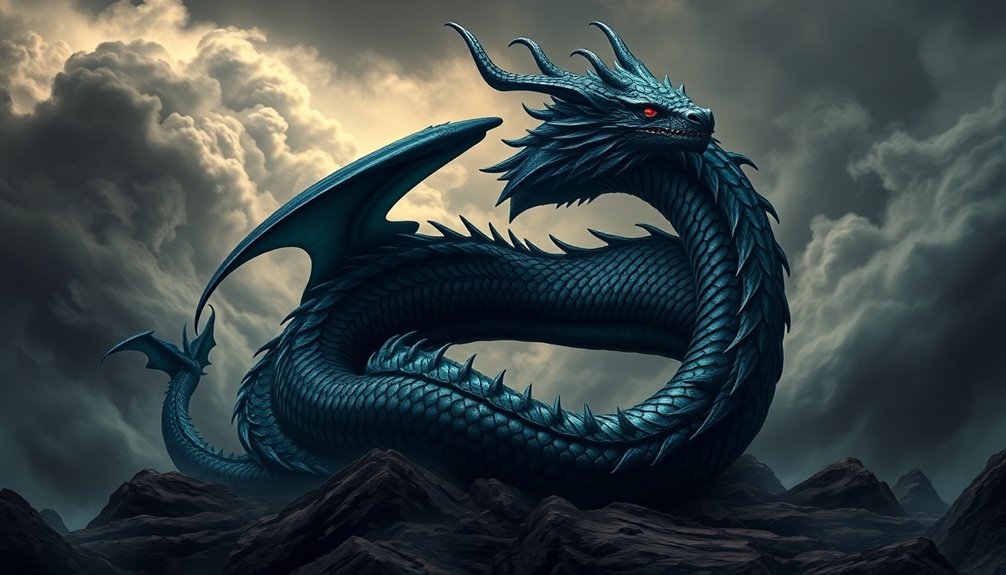
When exploring the origin and appearance of black dragons, you'll find a fascinating blend of mythology and fantasy. In Western lore, these dragons often belong to the chromatic category, symbolizing evil and destruction. However, their origins remain elusive, with no direct records.
In contrast, Chinese mythology, which dates back to at least 3000 BCE, features dragons linked to powerful leaders but doesn't specifically mention black dragons as malevolent beings. Chinese dragons are historically viewed as benevolent and wise, reflecting a stark contrast to the darker interpretations found in Western cultures.
Physically, black dragons are typically slender and wiry, standing out with their deep-socketed eyes and broad nasal openings that give them a skull-like appearance. Their curving, segmented horns transition from bone-colored at the base to black at the tips.
As they age, their glossy black scales thicken and dull, aiding their camouflage in dark habitats like swamps and ruins. These dragons have four legs, two wings, and a long tail, making them formidable creatures.
In fantasy worlds like Forgotten Realms, black dragons serve as powerful antagonists, often inhabiting inhospitable environments that become increasingly hostile. Their unique characteristics and adaptations reflect the fears and myths surrounding these enigmatic beings.
Symbolism and Meanings
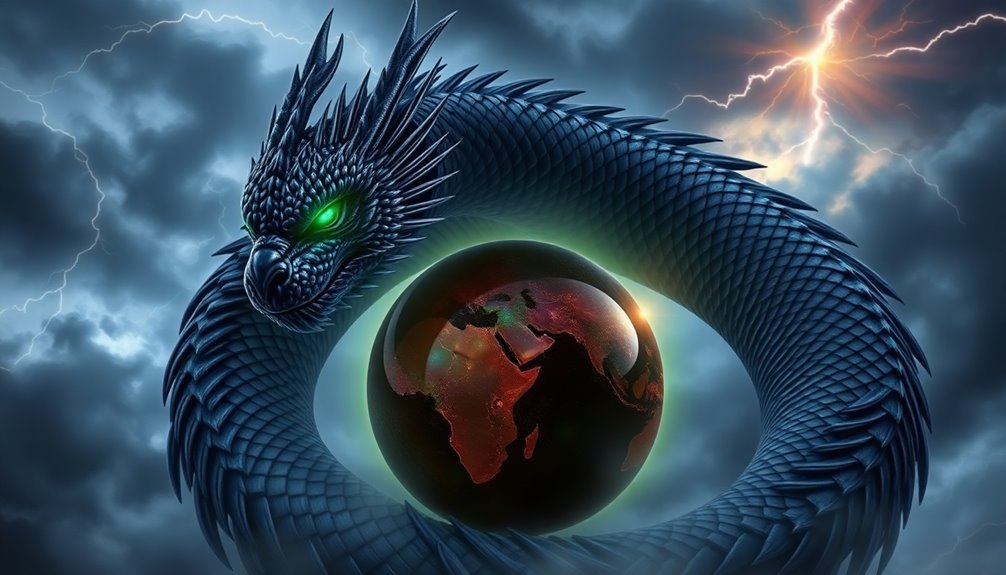
Steeped in rich symbolism, black dragons embody a complex interplay of wisdom, power, and protection. You'll often find them representing strength and dominance, serving as guardians of heavenly wisdom. In ancient Chinese culture, these majestic creatures symbolize the ultimate authority, embodying the ruler of all dragons and reflecting the yang energy associated with imperial power.
As a protective force, black dragons safeguard the worthy and bring blessings, believed to ensure bountiful harvests and prosperity. Their presence is prominent during celebrations, like dragon dances, which signify good luck and ward off evil spirits. The black dragon's association with water and rainfall emphasizes its role in ensuring agricultural abundance, which is vital for sustenance.
Delving into the black dragon's symbolism also reveals hidden wisdom and the journey into the shadows of the self, echoing themes of spiritual growth and transformation.
Moreover, black dragons play a vital role in various cultural and artistic expressions. They influence martial arts, particularly in Kung Fu, and appear in traditional performances and intricate artworks.
In modern contexts, they symbolize power, luck, and fortune, continuing to captivate imaginations across generations. Ultimately, black dragons remind you of the deeper mysteries of life, urging you to embrace the transformative journey within.
Connection to Water

Black dragons possess a profound connection to water, serving as symbols of abundance and fertility in Chinese mythology. You'll find that the black dragon, or "Xuanlong," is believed to control rainfall, which is vital for agriculture and prosperity. Its presence often heralds bountiful harvests, showcasing its influence over water and rainfall, which ensures the fertility of the land and the well-being of the people.
In Chinese culture, water is essential for life, and the black dragon embodies this significance. You'll notice that artists frequently depict the dragon in aquatic environments, showcasing its serpentine body and majestic presence. These artworks emphasize the dragon's benevolent nature, reinforcing its role in bringing good fortune through its mastery of water.
Additionally, the black dragon's connection to the element of water aligns with the cosmological system of Wu Xing, where it plays a crucial role in maintaining cosmic balance. By understanding this connection, you can appreciate how the black dragon not only symbolizes strength and power but also serves as a guardian of the essential life-giving qualities that water represents. The water dragon's presence facilitates facing painful experiences for peace and balance, echoing the black dragon's significance in nurturing life and prosperity.
Influence in Martial Arts
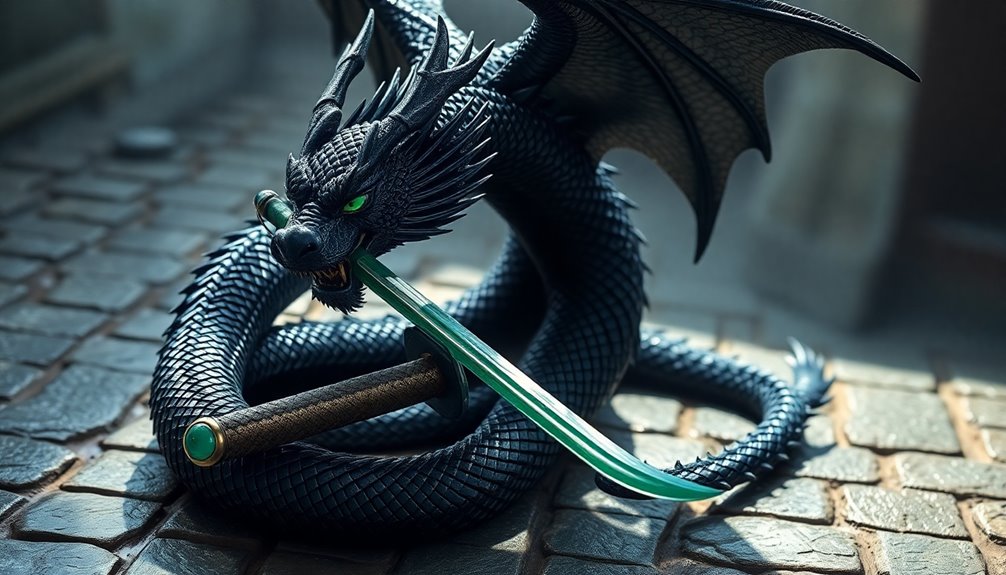
Historically, the influence of black dragons in martial arts has been significant, particularly through the formation of the Black Dragon Fighting Society (BDFS) in 1969. Founded by John Keehan in Chicago, the BDFS emerged as a response to racial prejudices within the martial arts community. Keehan's experience in Kokuryukai full-contact Kumite and connections with notable figures like Senzo Tanaka shaped the society's philosophy and style. The BDFS championed inclusivity, allowing practitioners like Victor Moore to compete, ultimately contributing to the rise of mixed martial arts. The Black Dragon style, inspired by the Shaolin Five Animal Style, emphasizes close-range fighting and sensitivity to an opponent's movements. Membership in the Black Dragon Fighting Society symbolizes elite status among martial artists, underscoring its influence in the martial arts community. You'll find that its techniques focus on fluid, circular attacks, embodying the dragon's ferocity and wisdom.
Representation in Art
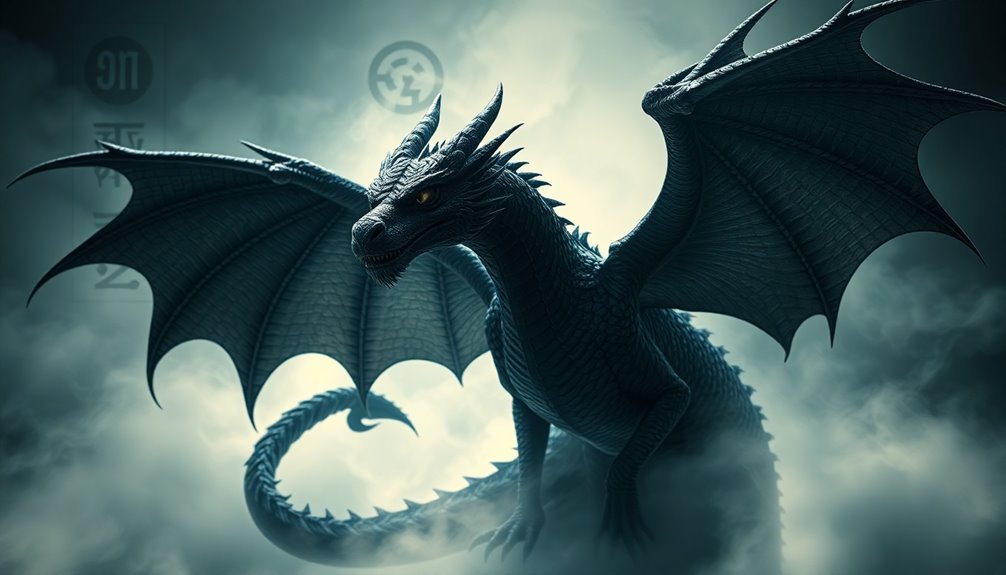
The representation of dragons in art captivates viewers with their dynamic forms and rich symbolism. In traditional Chinese art, black dragons are often depicted with a serpentine body and scaly skin, showcasing their association with water, rainfall, and good fortune.
You'll notice their eyes sparkling like stars, radiating mystery and magic, especially in vibrant paintings and intricate sculptures. The black dragon, in particular, symbolizes power, luck, and abundance, embodying control over natural elements. This color adds depth to its character, distinguishing it from red dragons, which represent passion, and blue dragons, symbolizing compassion. Artistic details like the dragon's beard, scale patterns, and tail curl are tied to ancient lore, enhancing its majestic presence in artworks. Additionally, these dragons are often associated with elemental powers, reflecting their significant role in various mythologies.
You might see a black dragon with a flaming pearl under its chin, representing a quest for wisdom. Throughout modern culture, the black dragon continues to inspire, appearing in movies, literature, and traditional performances like the dragon dance.
These artistic expressions capture its mystique and power, making the black dragon an enduring symbol of strength and protection across various mediums.
Spiritual and Mythological Roles
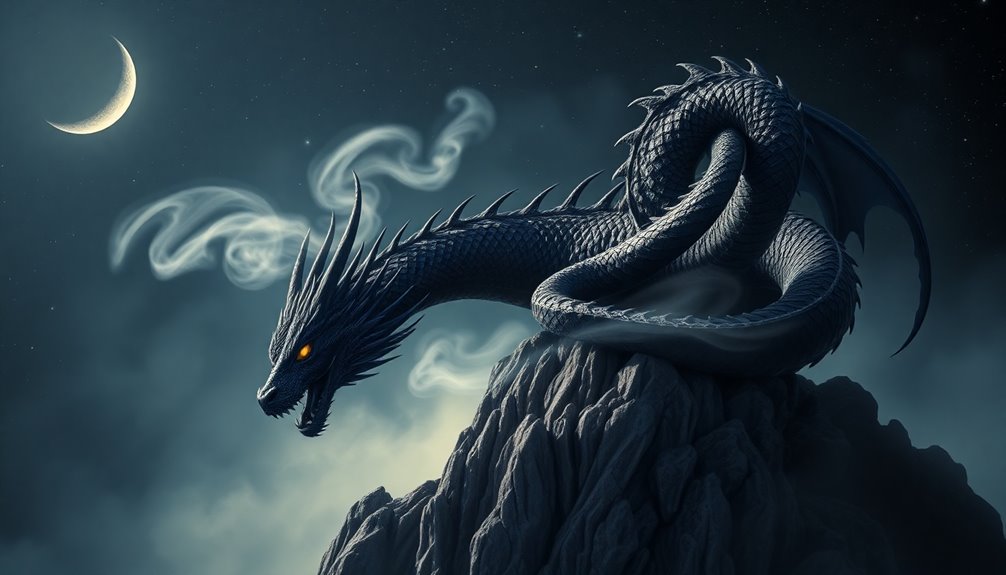
Dragons embody profound spiritual and mythological roles, serving as powerful symbols across various cultures. They often symbolize transformation and growth, encouraging you to embrace change and overcome obstacles in your life. When you reflect on your experiences, you tap into your divine potential, allowing new ideas to flourish during moments of rest.
The black dragon, in particular, represents wisdom and power, showcasing the strength and dominance found in Chinese culture. It embodies heavenly knowledge and the magic of the divine feminine, urging you to integrate your shadow sides for a complete self-understanding. Additionally, the black dragon provides a cocoon for nurturing new ideas, emphasizing the need for rest and relaxation to enhance creativity.
In mythology, dragons act as guardians, protecting the worthy and safeguarding treasures. They symbolize the balance between chaos and order, representing internal conflicts that necessitate overcoming fears and insecurities. By facing these challenges, you can undergo personal transformation and growth.
The black dragon also serves as a metaphorical barrier between life and death, reminding you of the importance of confronting the darker aspects of your psyche. Thus, the spiritual and mythological roles of dragons invite you to embark on a journey of self-discovery, wisdom, and empowerment.
Cultural Impact and Legacy
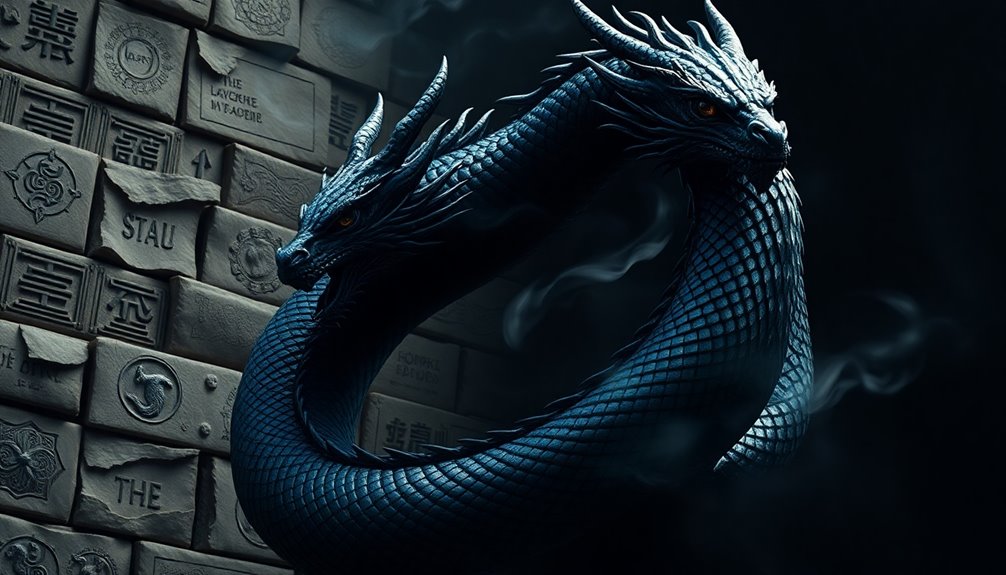
Black dragons have woven themselves into the fabric of cultural expression, influencing art, literature, and traditional practices across the globe. In traditional Chinese art, you'll find intricate sculptures and vibrant paintings that depict these majestic creatures with their serpentine bodies and scaly skin. They symbolize power, luck, and fortune, often highlighted in calligraphy and various artistic expressions.
In martial arts, the black dragon embodies inner strength and discipline, appearing prominently in styles of Kung Fu and the dragon dance during festivals, signifying good fortune. This powerful figure also holds protective qualities, revered by ancient emperors and integral to celebrations like the Dragon Boat Festival, where dragons symbolize imperial power and control over weather.
In modern media, black dragons maintain their allure, symbolizing adventure and mystery in movies, video games, and literature. Yet, their representation can diverge, as some criminal organizations use the symbol to evoke revenge or evil, contrasting sharply with its traditional benevolent image.
Frequently Asked Questions
How Do Black Dragons Differ From Western Dragons in Symbolism?
Black dragons differ significantly from Western dragons in symbolism.
You'll find that Chinese black dragons are often seen as benevolent, representing wisdom, water, and good fortune.
In contrast, Western black dragons are typically viewed as malevolent, embodying cunning and destruction.
While Chinese dragons are associated with protection and luck, Western dragons are often portrayed as greedy threats, creating a stark contrast in cultural representation and meaning.
What Are Common Myths Associated With Black Dragons in Chinese Culture?
In Chinese culture, black dragons often symbolize power, wisdom, and control over water.
You'll find myths where they bring rain to nourish crops or protect the land from floods.
Some stories depict them as guardians of secrets, safeguarding ancient knowledge.
Others associate them with imperial authority, highlighting their majestic presence.
As you explore these myths, you'll see how black dragons embody both benevolence and fear, reflecting nature's dualities in their tales.
Are Black Dragons Featured in Any Specific Chinese Festivals?
Black dragons aren't specifically featured in any traditional Chinese festivals, but their symbolism plays a role in celebrations like the Dragon Boat Festival.
You'll notice that dragons represent power, strength, and protection during these events. The rituals performed to ward off evil spirits echo the black dragon's protective qualities.
While you may not see black dragons directly, their influence is felt through the broader dragon symbolism celebrated in these cultural festivities.
How Can One Incorporate Black Dragon Symbolism Into Personal Practices?
You can incorporate black dragon symbolism into your personal practices by using figurines or pendants as focal points during meditation.
Embrace its transformative energy in your creative endeavors, like art or writing. Reflect on its qualities of courage and resilience, allowing them to guide you through challenges.
Additionally, integrate mindfulness practices that encourage deeper self-exploration, and consider home decor that reflects the strength and wisdom associated with the black dragon.
What Role Do Black Dragons Play in Modern Fantasy Literature?
In modern fantasy literature, black dragons often serve as powerful antagonists or complex characters that embody themes of darkness and chaos.
You'll find them ruling over their domains with fear, representing the unknown or the darker aspects of human nature.
These dragons can symbolize transformation and conflict, challenging heroes and driving narratives.
Their presence adds depth and tension, making them pivotal in shaping the story's emotional landscape and moral dilemmas.
Conclusion
In exploring black dragon symbolism, you uncover a creature intertwined with mystery, power, and guardianship. Its deep connection to water and martial arts showcases its multifaceted nature, while its representation in art and mythology highlights its cultural significance. As you reflect on these themes, you'll find that the black dragon serves not just as a symbol of strength, but also as a reminder of the secrets and wisdom hidden within the depths of your own journey.

